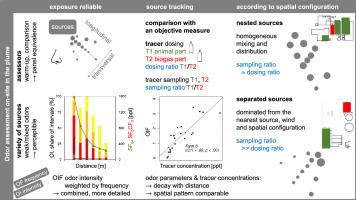烟羽中的气味影响评估-在两个空间农场配置中使用示踪气体的验证
Q2 Environmental Science
引用次数: 0
摘要
畜牧业设施和沼气厂由于其空间范围和区域来源的异质性,对气味评估构成了主要挑战。在这种情况下评估气味影响的方法必须克服批评点,例如缺乏可靠性和感官分析的主观性。本研究的目的是验证一个改进的程序,调查气味羽流由训练有素的评估。除了广泛采用的以气味频率为重点的方法外,我们还将气味强度和频率参数结合起来。由于弱气味和混合气味的相关性,非常弱(即可感知的)气味被包括在内,而不是只关注可识别的气味(清晰,明显的感知)。在两个农场,采用了示踪气体方法,以提供客观的分散度测量。气味参数(频率,频率加权气味强度)和示踪气体浓度的可比空间模式为区域来源的气味评估提供了许多重要发现。研究了两种空间源配置——动物部分和沼气部分嵌套或空间分离——并通过添加两种不同的示踪气体进行了区分。在嵌套结构中,示踪气体在羽流中均匀混合,因此只有组合源才能被绘制出来。相比之下,对于空间分离的源,羽流中的每个位置都受到单独的示踪气体和气味的暴露,这取决于源的排列、风向和邻近的建筑物。所提出的方法可以扩展到更复杂情况的可靠跟踪和分配。改进后的程序将有助于使气味影响评估客观化,并为制定适当的缓解战略铺平道路。本文章由计算机程序翻译,如有差异,请以英文原文为准。

Odor impact assessment in the plume – A validation using tracer gases in two spatial farm configurations
Livestock facilities and biogas plants pose major challenges for odor assessment due to their spatial extent and the heterogeneity of areal sources. Methods for assessing odor impact in such situations have to overcome points of criticism, such as the lack of reliability and subjectivity in sensory analysis. The aim of this study was to validate an improved procedure for investigating odor plumes by trained assessors. In addition to the widespread approach, which focuses on odor frequency, we combined the odor parameters of intensity and frequency. Due to the relevance of weak and mixed odors, very weak (i.e., perceptible) odors were included, rather than focusing only on recognizable odors (clear, distinct perception). On two farms, a tracer gas approach was implemented to provide an objective measure of dispersion. Comparable spatial patterns in odor parameters (frequency, frequency-weighted odor intensity) and tracer gas concentrations provide a number of key findings to consider in odor assessment of areal sources. Two spatial source configurations were studied—the animal part and the biogas part nested or spatially separated—and discriminated by dosing two different tracer gases. In nested configurations, tracer gases mix homogeneously in the plume and therefore only the combined source can be mapped. By contrast, for spatially separated sources, each position in the plume receives an individual exposure to tracer gases and odor, depending on source arrangement, wind direction, and the adjacent buildings. The presented approach can be extended to reliably track and assign more complex situations. The improved procedures will support objectifying odor impact assessment and pave the way for developing appropriate mitigation strategies.
求助全文
通过发布文献求助,成功后即可免费获取论文全文。
去求助
来源期刊

Environmental Advances
Environmental Science-Environmental Science (miscellaneous)
CiteScore
7.30
自引率
0.00%
发文量
165
审稿时长
12 weeks
期刊介绍:
 求助内容:
求助内容: 应助结果提醒方式:
应助结果提醒方式:


